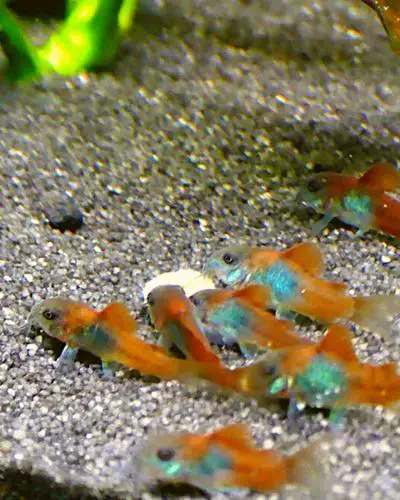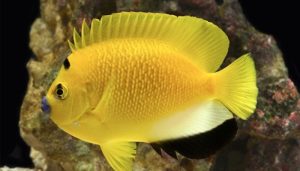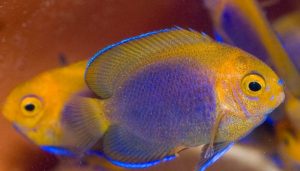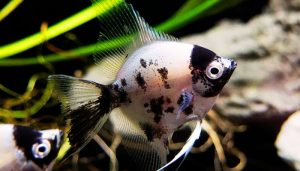Are you looking for a vibrant, easy-to-care-for bottom dweller for your aquarium? Then Orange Venezuelan Corydoras, is a lively freshwater fish native to the rivers of Venezuela.
These enchanting corys are known for their bright orange coloration and peaceful nature, making them a popular choice among aquarium enthusiasts.
These small catfish thrive in well-maintained tanks with soft substrates, hiding spots, and a balanced diet of sinking pellets and live, or frozen foods.
They are social creatures that do best in groups and require stable water conditions to stay healthy. With proper care, they can live up to five years, making them a fantastic addition to any community tank.

Understanding their anatomy, breeding habits, ideal tank setup, and dietary needs is essential for anyone looking to care for these genus Cory catfish.
This guide will provide comprehensive insights into ensuring the well-being of your Orange Venezuelan Cory catfish. But there’s more to keeping these beautiful fish happy and healthy! Want to know the best tankmates, ideal water parameters, and expert care tips?
Let’s dive into the complete guide and explore everything about the Corydoras Orange Venezuela.
Table of Contents
ToggleOrange Venezuelan Corydoras Anatomy and Appearance
The Venezuelan Orange Corydoras is a small, robust fish belonging to the Callichthyidae family. These corydoras aeneus fish typically exhibit a striking bright orange coloration that develops increasingly vivid hues as they mature.
Their bodies are covered with small, bony plates, providing protection and contributing to their unique look. The dorsal fin is prominent, often adorned with striking patterns that enhance their visual appeal.
The Cory catfish possesses a pair of barbels on their upper jaw, aiding in foraging for food along the substrate, which is essential for their survival in the wild. The distinct features of these fish make them both a fascinating and attractive addition to any aquarium.
In addition to their bright orange coloration, the Orange Venezuela Corydoras has a streamlined body shape that allows them to navigate through aquatic environments with ease. Their small size, typically reaching around two to three inches, makes them suitable for community tanks with various species.
These corys are also equipped with a specialized swim bladder that allows them to breathe air from the water’s surface, an adaptation that helps them thrive in low-oxygen environments. Their beautiful appearance and unique anatomical features contribute to their popularity among fishkeepers, who often admire their playful nature and social behavior within schools.
Breeding Venezuelan Corydoras
Breeding Corydora Orange Venezuela in an aquarium requires specific conditions to ensure successful reproduction. These corys typically breed during the rainy season in their natural habitat, so mimicking this environment is essential.
A well-maintained tank with stable water parameters, including a temperature range of 75-80°F and a pH of 6.8-7.2, is ideal for breeding.
To initiate the breeding process, provide a spawning substrate, such as sand or smooth gravel, where the female can lay her eggs. Additionally, they thrive in groups of at least six, as this social structure encourages breeding behavior.
During the breeding ritual, the male will court the female, often performing intricate displays that involve chasing and nudging. Once the female is ready to spawn, she will lay her eggs in batches on the substrate or on leaves of aquatic plants.
The male then fertilizes the eggs, which typically hatch within three to five days, depending on the water temperature.
After hatching, the fry require specialized care, including finely crushed pellet food and suitable cooler water conditions, to ensure their healthy development.
With patience and attention to detail, hobbyists can successfully breed these enchanting fish and enjoy watching the next generation of Venezuelan Orange Corydoras grow.
Ideal Aquarium Setup for Corydoras Orange Venezuela
Setting up an ideal aquarium for Orange Venezuelan Cory catfish is crucial for their well-being and happiness. A minimum tank size of 20 gallons is recommended to provide ample swimming space and to accommodate a school of at least six corys.
The substrate should consist of smooth gravel or sand, as sharp materials can harm their delicate bodies. Incorporating driftwood and live plants not only enhances the aesthetic appeal of the tank but also creates hiding spots and reduces stress for the fish.
A well-planted aquarium mimics their natural habitat, making them feel secure and comfortable.
In terms of water parameters, maintaining clean and well-filtered water is vital for the health of your Corydoras Orange Venezuela. A filtration system that provides gentle water movement is ideal, as these corys prefer calmer environments.
Regular water changes of 20% to 30% weekly help maintain optimal water conditions and remove harmful toxins. The addition of aquatic plants like java moss and anubias can improve water quality and provide a natural feel to the aquarium.
Creating a thriving planted community tank that includes dwarf cichlids and other peaceful species can lead to a dynamic and harmonious aquarium environment, enhancing the overall experience for both fish and aquarists alike.
Venezuelan Orange Corydoras Diet and Feeding
Feeding Orange Venezuela Corydoras requires a balanced diet to promote their health and coloration. These corys are omnivorous, so a varied diet that includes high-quality pellets, frozen or live foods, and vegetable matter is essential.
Specialized Cory catfish pellets provide the necessary nutrients and are readily accepted by these fish. Additionally, incorporating protein rich foods such as bloodworms, brine shrimp, and blanched vegetables like zucchini or spinach can enhance their diet.
Feeding them in small amounts two to three times a day ensures they receive adequate nutrition without overfeeding.
It’s important to observe their feeding habits, as corydoras often prefer to scavenge along the substrate for leftover food. This behavior not only keeps the tank clean but also mimics their natural foraging instincts.
Offering sinking pellets will ensure that all fish, including those lower in the pecking order, have access to food. Moreover, ensuring that the food reaches the bottom allows the Corydoras Orange Venezuela fish to thrive in their environment.
Providing a diverse diet not only supports their growth but also contributes to the vivid coloration that makes these fish so sought after in the aquarium hobby.
What is the Difference Between Bronze Cory and Orange Venezuelan Cory?
The main difference between bronze Corydoras and Corydora Orange Venezuela lies in their coloration and habitat preferences. Bronze corydoras, or bronze Cory catfish, typically exhibit a greenish-bronze hue, while the enigmatic venezuelan corydoras (corydoras venezuelanus) develops increasingly bright orange coloration along its body.
Both species are adaptable corydoras catfish that thrive in a thriving planted community tank with a smooth gravel substrate or sand, but venezuelan cories prefer a pH of around 6.8 and require ample substrate and plenty of hiding spots.
When setting up a venezuelan Cory tank, including decorations that resemble their natural habitat near the rio is essential. These little fish enjoy the company of tank-bred species like Rasboras, dwarf shrimp, and amano shrimp.
In contrast to the bronze variety, which is often exported in larger numbers, venezuelan cories grow less commonly in the aquarium trade. Both types thrive well in a tank that ensures a live arrival guarantee and maintains low levels of ammonia for optimal health.
Conclusion
In conclusion, caring for Venezuelan Orange Corydoras requires understanding their unique needs, including their anatomy, breeding habits, ideal tank setup, and dietary preferences. With the right environment and care, these charming corydoras can thrive in a community aquarium, bringing joy and beauty to any aquatic setting. Their bright orange coloration and playful behavior make them a favorite among fish lovers. By following this guide and providing the necessary conditions, hobbyists can enjoy the rewarding experience of keeping Orange Venezuelan Corydoras and witness the wonders of these remarkable fish.
You might also like
- How Often Do Cory Catfish Breed? Beginners Kickstart (Guide)
- Do Cory Catfish Eat Snails? Is it Even Possible (Yes, or No)
- Green Phantom Pleco L200: A Complete Guide (For Beginners)
- Raphael Catfish Spotted: Diet, Tank Mates, Diseases & (More)
- Tiger Shovelnose Catfish: #1 Care Guide (You’ll Ever Need)
- Blue Phantom Pleco (L128) – Size, Price, Diseases & More
- Cory Catfish Water Parameters: Avoid These 3 Deadly Mistakes!
- Corydora Melini 101: False Bandit Cory Comprehensive Guide




